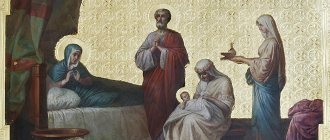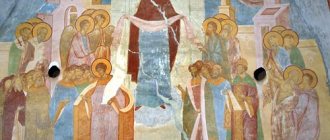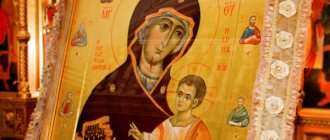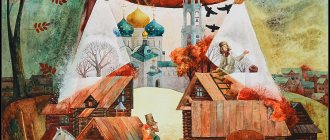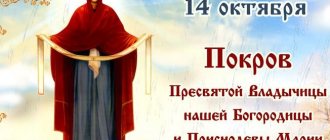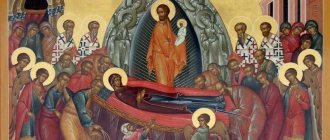history of the holiday
From the Gospel we learn only the main, most important events in the life of the Mother of God, but it does not say either about the circumstances of Her birth or about Her further life. These details are brought to us by church tradition, that is, ancient legends, church historical works, as well as hymnographic liturgical heritage, that is, the texts of church services. The Church calls the parents of the Most Holy Theotokos, Joachim and Anna, “godfathers.”
Joachim was a descendant of King David, Anna came from the family of the high priest Aaron. They led a righteous and pious life. Tradition says that they kept only a third of the income for themselves - the rest was distributed to the needy and donated to the temple. Having reached old age, the couple remained childless.
It should be said that childlessness was considered among the Jewish people as a punishment for sins, and therefore Joachim and Anna endured unfair accusations of secret sins. But they did not despair, but hoped for the mercy of God and believed that the Lord could send them a child even in old age, as He once did to Abraham and Sarah.
Saints Joachim and Anna. Fresco from the Dionysiates Monastery on Mount Athos
On one of the great Jewish holidays, Joachim came to the Jerusalem temple to offer a sacrifice to God according to the law of Moses. But the high priest did not accept Joachim’s gifts, accusing him of sins, for which the Lord punishes him with childlessness. The saddened Joachim did not return home, but went into the desert where his flocks grazed. Anna, having learned about what happened in the temple, was also saddened. However, they did not grumble against the Lord, but prayed fervently, asking Him for mercy.
Their prayer was heard by the Lord. According to legend, an Angel appeared to Joachim in the desert, and Anna in the garden with the joyful news that they would have a daughter. Both immediately went to Jerusalem and met at the Golden Gate. At the right time, they had a daughter, who was named Maria. Joachim and Anna joyfully thanked the Lord and promised to devote their child to serving God. The date of the Nativity of the Mother of God is exactly 9 months from the date of the Orthodox feast of the Conception of St. Anne (December 22).
One of the first mentions of the Feast of the Nativity of the Blessed Virgin Mary occurs in the 5th century in the words of Saint Proclus, Archbishop of Constantinople (439–446). The Jacobites and Nestorians, who separated from the Orthodox Church in the 5th century, also have a holiday on September 8 called “The Nativity of the Lady Mary.”
In the 7th–8th centuries, the holiday was already celebrated with great solemnity in the Greek Church. The official approval of this holiday in the Byzantine Empire is attributed to Emperor Mauritius.
House of Joachim and Anna
The House of Joachim and Anna is one of the Christian landmarks of Jerusalem. As Church Tradition says, the Virgin Mary was born in the house of her parents - the righteous Joachim and Anna. It was located in the northeastern part of Jerusalem, now the territory of the Muslim Quarter of the Old City, near the Lion Gate.
Orthodox and Catholics still argue over where exactly the house stood, and built the monastery and basilica 70 meters apart.
The Orthodox monastery of St. Anne is a place of pilgrimage for many Christians around the world. On the ground floor of the monastery there is a church in honor of the Nativity of the Mother of God, and under the monastery building there is an ancient cave. It is believed that this cave is part of the house of Joachim and Anna. KIKTENKO Elizaveta
Magazine "Foma"
How is the Divine Service held on the Nativity of the Blessed Virgin Mary?
The holiday service includes the works of St. John of Damascus (8th century) - the first canon; St. Andrew of Crete (VII century) - second canon; Herman, Patriarch of Constantinople (8th century) - stichera on verse; Anatoly, Bishop of Thessalonica (IX century) - some stichera on the lithium; Stephen and Sergius of Svyatogradtsev (IX century) - stichera on “I cried to the Lord” and some on litia and stichena.
The stichera for the feast of the Nativity of the Virgin Mary contain the doctrinal idea that in the person of the Virgin Mary the Lord prepared for Himself an earthly Throne and a Royal Palace; that the Mother of God surpasses all women in Her greatness, because the Son of God was born from Her; that, having resolved the infertility of the parents of the Mother of God,
The Lord can also resolve our spiritual infertility, i.e. give us the power to do good. At the same time, in the same stichera, all people, both Old Testament and New Testament (present in the temple) are invited to rejoice and glorify the Mother of God, because through Her heaven was united with earth, hell was put to shame, the doors of heaven, i.e. The Kingdom of Heaven was again revealed to people, we were renewed and “deified”, i.e. became partakers of God's grace.
In the proverbs read on the feast of the Nativity of the Virgin Mary, the first (Gen. XXVIII, 10-17) speaks of Jacob’s vision of a ladder, which prefigured the Mother of God, connecting heaven with earth; the second proverb (Ezek. XLIII, 27; XLIV, 1–4) contains the prophecy of Ezekiel, who called the Mother of God the gate through which the Holy Elder and the Holy Builder passed; the third (Prov. IX, 1-11) speaks of the House prepared for itself by the Hypostatic Wisdom, i.e. Jesus Christ (this house, built by Wisdom - the Mother of God, the Blessed Virgin Mary, into whom the Lord dwelt).
Who is congratulated on this special day?
On such a holiday, it is customary to congratulate all relatives and friends, to wish them health and prosperity. Particular attention is given to young couples who have lived together for 2-3 years or have recently gotten married.
Mother of God holidays are celebrations in honor of the Mother of God, therefore they are considered feminine. They congratulated the mothers, thanked them for this life, for their help, for their good deeds. No gifts were given, although small gifts to relatives were welcome. It was customary to give small icons with the face of the Virgin Mary to those who were especially dear to them.
Interesting folk traditions for the feast of the Nativity of the Virgin Mary
The Feast of the Nativity of the Blessed Virgin Mary is also called “Little Most Pure”, “Aspos’ Day”. According to folk legend, the time closest to this day was called Ospozhniki, Spozhinki or Gospozhinki. The scope of the festive festivities depended on how the harvest turned out in the new year. If the harvest was good, the Mistresses celebrated for a whole week: the more productive the summer, the longer the holiday.
The village “feast”, timed to coincide with the festivities of the church cycle, took place in the period from the Dormition of the Virgin Mary to the Intercession. The feast unfolded according to all the laws of hospitality: they brewed beer according to the number of guests, slaughtered a sheep or ram, prepared beef dishes, used the head and legs of a bull for jelly, took fish out of the kulebyak, and also, despite the fact that the holiday was a feast day, baked pie made from homemade wheat flour mixed with purchased semolina.
A day or two before the holiday, children called relatives to a feast, giving preference to those who were willing to pay for food at their holiday. An exception was made for sons-in-law, especially young ones: neither father-in-law nor mother-in-law ignored them with an invitation, even if they themselves did not expect a response. It was very important that there should be good relations between the sons-in-law and the father-in-law and mother-in-law of the daughter, as in the proverb: “Not for the dog-in-law, but for the dear child.”
The matchmaker and matchmaker of their son's father-in-law and mother-in-law were the most important guests, who sat at the table in the front corner, right under the icons. Village fun was broader and more varied in the area where there were churches in honor of the Nativity of the Virgin Mary, then in these villages various fairs were held dedicated to the holiday.
What does it symbolize?
“A real holiday is the beginning of the holidays for us. It serves as the door to grace and truth. Now the Creator of everything has established an animated temple and creation (in the person of the Virgin Mary) is being prepared for a new home for the Creator” (St. Andrew of Crete)
On the twelfth feast of the Nativity of the Blessed Virgin Mary, the whole Universe rejoices. Through the Virgin Christ comes into the world.
In the patristic teachings we find an interpretation of the great event. Just as through his wife, the ancestor Eve, humanity fell and was enslaved by sin and death, so through the Most Holy Theotokos the Incarnation occurs, and humanity is saved from eternal death.
But salvation and the Incarnation would have been impossible without the simple words spoken by the young Ever-Virgin Mary:
“Behold, the Servant of the Lord; let it be done to me according to your word.” (Luke 1:38).
Icons dedicated to the Nativity of the Virgin Mary
The oldest images of the feast of the Nativity of the Virgin Mary have been known since the 6th century and became widespread in Byzantine and Russian art in the 11th–12th centuries. The main elements of iconography go back to this time: Anna in a red maforia on a high bed, supported by a maid; on the right or left below is a scene of the baby being washed. Three women with gifts approach Anna. The Father of the Mother of God, Righteous Joachim, looks out from the window of the chamber.
Nativity of the Virgin Mary. Mid-14th century State Tretyakov Gallery, Moscow
Nativity of the Virgin Mary. Double-sided tablet icon. End of the 15th - beginning of the 16th centuries. Novgorod State historical, architectural and art museum-reserve
Fragment of the icon of the Nativity of the Virgin. XVI century. Museum named after A. Rubleva
Nativity of the Virgin Mary. Nevyansk icon. 1830-1840
Nativity of the Virgin Mary with Life. XVI century. From the local row of the Cathedral of the Nativity of the Virgin in Ustyuzhna
Nativity of the Blessed Virgin Mary. From the festive ceremony. Mid-17th century State Museum-Reserve "Rostov Kremlin", Rostov the Great
Nativity of the Virgin Mary. Nevyansk icon. Circle of Bogatyrevs. Second quarter of the 19th century.
Temples in the name of the Nativity of the Virgin Mary in Rus'
Temples and monasteries in honor of the Nativity of the Virgin Mary were built in the 12th–14th centuries throughout Rus'. The patronage of the Mother of God in the liberation of Russian lands from the Tatar-Mongol yoke was reflected in the massive construction of churches dedicated to the feasts of the Mother of God. The Cathedral of the Bobrenev Monastery (1381) near Kolomna and the gate church of the Andronikov Monastery were dedicated to the Nativity of the Virgin Mary.
Bobrenev Monastery near Kolomna
The widow of Grand Duke Dimitri Donskoy, Princess Euphrosyne, founded the Ascension Monastery in the Moscow Kremlin in 1392 and erected a white-stone church in honor of the Nativity of the Virgin Mary in the traditions of Vladimir-Suzdal architecture. The church was painted in 1395 by the outstanding icon painters Theophanes the Greek and Simeon the Black.
Ascension Monastery. 1850-1865
In honor of the Nativity of the Blessed Virgin Mary, the Bogolyubsky Monastery in the Vladimir region was consecrated. The monastery was founded in the 12th century, and the main temple was built between 1158 and 1751. The Nativity of the Virgin Cathedral was decorated with carved reliefs and frescoes, copper and gilding, ceramic floors and stained glass windows. Round, marble-painted columns supported the vaults.
The ancient cathedral collapsed due to disrepair and inept alterations and in the 18th century. was replaced with a new one. A bell tower tent was built over the staircase tower. The cell building took the place of the princely chambers. In the 19th century The ancient gates with a gate church were replaced by the Assumption Gate Church with a bell tower, and at the same time a huge five-domed cathedral was built. On June 3, 1923, the monastery was closed, and in 1991 the revival of the monastery began.
Cathedral of the Nativity of the Virgin Mary of the Bogolyubsky Monastery in the Vladimir region
In honor of the Nativity of the Blessed Virgin Mary, the Ferapontov Monastery in the village was consecrated. Ferapontovo, Vologda region. The Cathedral of the Nativity of the Virgin Mary was built in 1490. Its volume, placed on a high basement, ends with three tiers of kokoshniks and a small elegant drum. The facades at the top are decorated with belts of balusters and ceramic slabs with floral patterns, at the bottom - with a belt with teratological (animal) and plant patterns, which are a reminiscence of white stone carvings of Vladimir architecture.
Three perspective portals are carved from white limestone. Inside, the cathedral is divided by four square pillars into three naves with raised arches under the drum. In 1924, the Ferapontov Monastery of the Nativity of the Mother of God was closed. Since 1975, the monastery has been used as a museum. In 2021, the Synod decided to resume monastic life in the monastery.
Cathedral in honor of the Nativity of the Blessed Virgin Mary in the village. Ferapontovo, Vologda region
In honor of the Nativity of the Blessed Virgin Mary, a monastery in Moscow was consecrated. The Nativity of the Virgin Cathedral was built in 1501-1505. The cathedral building was badly damaged by a fire in 1547, but by 1550 it was completely restored. The four-pillar, three-apse temple has one dome. The lower volume is cubic. The corner parts are covered with cross vaults and are lowered in relation to the central part, which is cruciform in plan. Stepped girth arches carry a high drum with a helmet-shaped head. The completion has a pyramidal appearance. Under the drum there are two rows of kokoshniks.
In 1676-1687 The cathedral belfry was dismantled and a hipped bell tower was added in its place from the southwest. By the end of the 18th century. The Nativity of the Virgin Cathedral was rebuilt: the southern extension was extended along the entire southern facade, and in the north another volume was erected along the entire length of the facade, which served as a covered porch. In 1835, the cathedral's hipped bell tower was damaged by a lightning strike and was dismantled. The Nativity of the Mother of God Monastery was closed in 1921. In 1960-64. the monastery cathedral was partially restored; During restoration, it was returned to its original appearance. In 1991, the monastery buildings were returned to the Russian Orthodox Church.
Ensemble of the monastery in honor of the Nativity of the Blessed Virgin Mary in Moscow
In honor of the Nativity of the Blessed Virgin Mary, the Pafnutii Borovsky Monastery was consecrated in the village of Roshcha, Kaluga region. Nativity of the Virgin Mary St. Paphnutius Borovsky Monastery was founded in 1444 by the Monk Paphnutius Borovsky. Initially, a small wooden church of the Nativity of the Virgin Mary was built here, on the site of which a small white stone church was soon built. At the beginning of the 16th century. defensive fortifications were erected. In 1511, a stone refectory was built, and in the eighties of the same century, a cathedral was erected on the site of the church.
In 1610, the Borovsky Monastery was besieged by the troops of False Dmitry II. The betrayal of two governors allowed the “Tushino thief” to enter the fortress. In a terrible massacre on the territory of the monastery itself, 12,000 people died. The monastery was burned, along with all the documents of its early history. After the end of the Troubles, much was restored, new towers and temples were erected. In the middle of the 17th century. a bell tower was built.
In the middle of the 17th century, in the Paphnutian Monastery, at different times, Archpriest Avvakum and the noblewoman Morozova were imprisoned twice, who died there by starvation in an earthen pit. In 1923, a correctional colony was located on the territory of the monastery, then an agricultural technical school. Since 1960, restoration work has been carried out. The Paphnutian Monastery was again transferred to the Church in 1991.
Nativity of the Blessed Virgin Mary St. Paphnutiev Borovsky Monastery
In honor of the Nativity of the Virgin Mary, a church was consecrated in Volokolamsk, Moscow region. The church served as the cathedral of the Vozmischensky Monastery, known since the 15th century. and abolished in 1764. The church building was built in 1535.
The brick four-pillar temple was originally three-domed. The two eastern drums were dismantled in 1792, when the roof covering was converted into a hipped roof. The walls are divided by blades into three unequal spindles, completed with semicircular zakomaras. In the middle zakomars there are round icon cases. The walls in the middle of the height are surrounded by a cornice, which turns into the cornice of the apses.
Of the three portals, the northern perspective portal with a keel-shaped archivolt, ceramic capitals and melons has been preserved. The drum is completed with a helmet-shaped head with an openwork cross from the 17th century. The plaster decoration of the drum dates back to the middle of the 19th century. The three-tier bell tower and the two-aisle refectory were built in 1850. During the years of Soviet power, the temple remained operational. Only during the Great Patriotic War were services briefly interrupted, but soon resumed.
Church of the Nativity of the Virgin in Volokolamsk
In honor of the Nativity of the Blessed Virgin Mary, the Medvedev Hermitage in the Dmitrovsky district of the Moscow region was consecrated. The first construction of a wooden church in the Medvedeva Hermitage dates back to 1360. In 1547, construction began on a stone church in honor of the Nativity of the Blessed Virgin Mary in the village of the Medvedeva Hermitage.
The small brick, four-pillar, single-domed church with three equal-sized apses belongs to the cross-domed type. The smooth planes of the facades are divided by blades into three equal spindles and decorated at the base of the semicircular zakomara with a terracotta ornamental frieze. Low slit-like windows are located at intervals on two levels. The entrances to the cathedral are accentuated by promising keel-shaped portals. The covering of the temple has undergone significant changes. Initially, the cathedral was completed, in addition to the zakomars, with two rows of kokoshniks located parallel to the facade planes.
Their square pedestals are hidden by a late hipped roof. The brick light drum and onion head are new. In the 16th century, a three-tier bell tower was also built, rebuilt in 1871. At the same time, from the neighboring village. Dulov, the Spasskaya Church was transported to Medvedev Hermitage. In the 19th century, the Church of the Nativity of the Blessed Virgin Mary was reconstructed. In 1937, the Medvedeva Mother of God-Nativity Hermitage was closed and its property was looted. In 1999, the Church of the Nativity of the Blessed Virgin Mary was transferred to the Russian Orthodox Church. The existing temple complex is slowly being revived.
Church of the Nativity of the Virgin Mary of the same name in the Medvedev Hermitage in the Dmitrovsky district of the Moscow region
In honor of the Nativity of the Blessed Virgin Mary, the Luzhetsky Ferapontov Monastery in the city of Mozhaisk, Moscow Region, founded in 1408, was consecrated. The Cathedral of the Nativity of the Blessed Virgin Mary was built in the first half of the 16th century. It was rebuilt in the middle of the 18th century, the galleries surrounding the cathedral were dismantled. In the 1960s of the 20th century it was restored. In 1922, the monastery was officially closed and destroyed. In 1994 it was returned to the Russian Orthodox Church. The relics of St. Ferapont of Belozersky rest in the Nativity of the Virgin Cathedral.
In honor of the Nativity of the Blessed Virgin Mary, the Savvino-Storozhevsky Monastery was consecrated in the city of Zvenigorod, Moscow region. The monastery was founded in 1398, and the cross-domed, four-pillar, single-domed cathedral was built in 1405. The facades, top of the apses and drums are decorated with belts of white stone carvings. The portals are perspective with a keeled top. Completion with three tiers of zakomar in the 18th-19th centuries. was replaced with a hip roof. The onion head dates back to the 17th century. In mid-1919 the monastery was closed, and in the 1990s. returned to the Russian Orthodox Church.
Cathedral of the Nativity of the Virgin Mary of the Savvino-Storozhevsky Monastery in Zvenigorod, Moscow Region
In honor of the Nativity of the Blessed Virgin Mary, the Anthony Monastery in Veliky Novgorod was consecrated. The monastery was founded in 1106. The First Novgorod Chronicle notes the foundation of the cathedral in honor of the Nativity of the Blessed Virgin Mary in 1117, and in 1119 it speaks of the completion of construction. The building was a three-nave, single-domed temple with a round staircase tower. The cathedral has survived to this day with alterations and reconstructions. Instead of narrow windows with a semi-circular ending, wide windows were punched.
A hipped iron roof was installed over the vaulted roof. The domes acquired a bulbous shape characteristic of the late period. The porch galleries surrounding the cathedral were also added later. What is interesting in the composition of the building is the asymmetrical arrangement of three chapters, one of which is crowned by a round tower extended from the general volume.
This tower contains a staircase leading to the “polati” - the modern choir of the cathedral. In 1920, the Anthony Monastery was abolished. Today, the monastery buildings are part of the Novgorod Museum-Reserve. On the territory of the monastery there are a number of faculties of the Novgorod State University named after Yaroslav the Wise.
Cathedral of the Nativity of the Virgin Mary at the Anthony Monastery in Veliky Novgorod
In honor of the Nativity of the Blessed Virgin Mary, the Tithe Monastery in Veliky Novgorod was consecrated. The first mention of the monastery dates back to 1327. The stone Church of the Nativity of the Mother of God was built in 1397. Initially it was a four-pillar, single-dome, single-apse church. Since 1918, the Novgorod GubChK and the Novgorod department of the OGPU have been located in the Desyatinny Monastery.
The basement of the Nativity Cathedral was adapted into cells for prisoners, and the abbot's building - into a club for security officers. In 1929, the cemetery church of All Saints was demolished and the monastery cemetery was destroyed. The Cathedral of the Nativity of the Virgin Mary suffered serious damage during the Great Patriotic War, but retained its dome and sometimes destroyed walls. In the mid-1950s it was demolished and dismantled into bricks. The monastery has survived in fragments. In addition to the monastery bell tower, the buildings of the monastery premises and the ruins of the Church of the Nativity of the Virgin Mary have been preserved.
Desyatinny Monastery before the revolution
